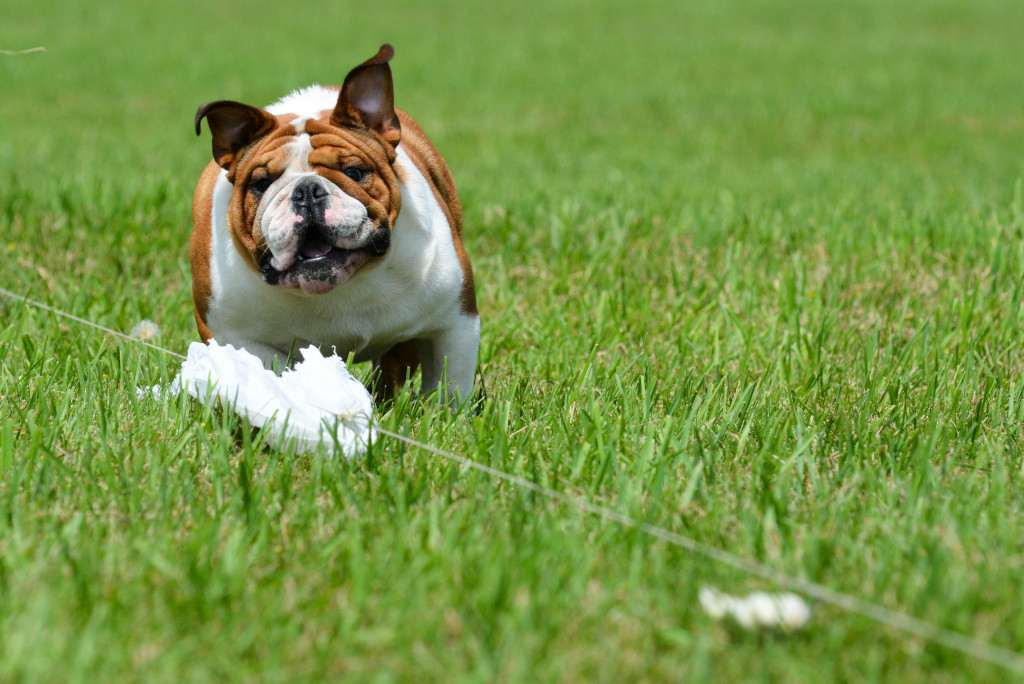
Got frustrated with your dog running off every time they are let loose in the yard?
You’re not alone! Even dog owners with fenced-in yards struggle to keep their canines contained.
And as you can imagine, this can be a huge safety concern. While you can use a GPS tracker to keep track of your fido’s whereabouts and locate them if they run away, they may still be at risk of getting hit by a car or attacked by other animals when roaming the streets.
So how can we let our canine companions have the freedom and fun they need without worrying about them running away? More precisely, how can we train them to stay in the yard without a fence?
Well. It’s actually not as difficult as you might think! There are a number of methods you can use to train your dog to stay within the boundaries of your property, and we’ll explore them below.
Use an Invisible Fence
One popular method of training dogs to stay in the yard is by using an invisible fence. There are two types of invisible fences for dogs: wired and wireless.
Wired invisible fences, also known as in-ground fences, underground fences, or electric dog fences, require you to install a wire underground around the perimeter of your yard, which picks up the signal sent to your dog’s receiver collar via a transmitter. This collar will emit beeps and/ or vibrations depending on the model you choose to remind your dog to stay in the yard. If your pooch ignores the warning and crosses into the “off-limits” zone, it will deliver a mild static shock.
Wireless invisible fences work similarly, in which your dog will receive a warning beep when they get close to the perimeter and static correction if they cross over it, teaching them to stay within the safe zone of your yard. The difference is that the transmitter emits a radio frequency that creates a circular boundary and communicates with your dog’s receiver collar directly instead, meaning there is no wire running underground.
Either option is a great way to train your pup to stay out of the street and within your property’s boundaries. Although wire-free invisible fences are easier to install and maintain since there is no wire to bury or replace, that doesn’t necessarily mean they are better. Both wired and wireless fences have their pros and cons, so be sure to carefully consider which option would be best for you and your furry friend before making your decision.
But whichever type of invisible fence you choose, it’s crucial to know these systems require you to train your dog to be effective. This includes teaching them exactly where the “off-limits” area is, what the warning signals (i.e., beeps and vibrations from the collar) mean, and what is expected of them when they receive those signals.
Here are a few tips to help you get started:
- After installing the invisible fence, start placing flags around the perimeter of your yard at the locations the wire is buried (for wired fences) or where the radio signal is emitted (for wireless fences). This will give your dog a visual cue of where the boundary is.
- Put the receiver collar on your dog and take them outside with them on a leash. Approach the boundary line and when the collar beeps, lead your pup back inside the yard and reward them with treats or praise. Repeat this process several times and ensure to do it at different training flags around the perimeter, so they know the entire boundary, not just one specific area.
- Once your dog understands that they need to go back inside when they hear the beep, you will want to turn on the static correction mode. Always start with the lowest setting and only increase it if necessary. Approach the boundary line with your dog on a leash, and you will want to walk them through the fence this time (where the collar will emit a mild static shock). As soon as they receive the correction, immediately lead them inside the yard and praise them. Repeat this process for a few days until your fido understands they must stay in the safe zone.
- When your canine understands that they need to stay within the boundary, you will want to test them by introducing distractions. This includes having someone hold their favorite toy or throw balls just outside the perimeter, having a friend or family member walk by, or anything else that might tempt them to leave the yard. If they stay within the boundary, praise them for remaining in the safe zone. If they cross over despite the warnings, immediately lead them back inside and continue practicing with different distractions until they resist the temptation.
- The final step is to let your furry friend run free in the yard without a leash and randomly test them with different distractions as you did in step four to ensure they will stay within the safe zone regardless of what distraction comes their way. Then, you can remove the flags after a few weeks or when you’re confident that your pooch won’t leave the designated area.
You May Also Like: Are In-Ground Fences for Dogs Effective?
Boundary Train Your Dog With a Remote Training Collar

You may have heard a lot about remote training collars or e-collars and may be on the fence about using one to train your dog. After all, there are a lot of people that are strongly against using these devices, although some will tell you these devices are the best thing since sliced bread.
And I’m not here to argue whether or not remote training collars are good or bad and tell you if you should or shouldn’t use one. I will leave that decision up to you. However, I will say that they are an effective tool in helping you train your dog if used correctly.
For those who are unfamiliar, a remote training collar, also known as a shock collar or an e-collar, is a training device commonly used to train dogs for hunting, correct unwanted behavior like excessive barking and pulling on the leash, as well as for off-leash recall training. And, of course, you can also use it for boundary training.
This training tool comes with a handheld remote that you can use to deliver correction signals, be it a beep, vibration, or static stimulation (at a low level), just like an invisible fence, to teach your pup where they shouldn’t go. And before you start using one, here are a few things you need to know.
- Your dog should already know basic obedience commands like sit, stay, come, and down before you start using a remote training collar.
- The device should only be used to get your dog’s attention, not to punish your dog.
- Always start with the lowest setting and only increase it if necessary.
The steps on how to boundary train your dog with a shock collar are exactly the same as the process of training your dog with an invisible fence, in which you will want to set up the boundary by placing training flags, then introduce the warning tone, move on to static correction mode, add distractions, etc. So I’m not going to go into detail about that process again.
The only difference is that with a shock collar, you will have to deliver the static stimulation yourself when your dog crosses the boundary line instead of the collar doing it automatically. And the timing of the correction is key, as you want your pup to associate the correction with crossing the boundary line, not with anything else.
Then, why not just use an invisible fence? You might ask.
Well.
With remote training collars, you have more control as you can determine when and where to deliver the correction. Plus, you can adjust the intensity level from the remote, which you cannot do with an invisible fence. Not to mention the many other benefits and things you can do with a remote collar.Done
You May Also Like: How to Properly Train Your Dog With an E-Collar
Boundary Train Your Dog Using a Clicker
If you aren’t comfortable using a dog shock collar to train your pooch, then the traditional reward-based method, which involves using a clicker and treats, is the way to go.
Here’s how it works:
- Similar to the other two methods, you’ll first want to set up your boundary. You can use flags or ropes tied to a series of stakes to mark the perimeter of your yard or whichever area you want your dog to stay in.
- Once the boundary is set, have your dog on a leash and walk them inside the perimeter while clicking and giving them treats.
- Now, it’s time to introduce the boundary. Again, have your dog on a leash. But this time, you want to stand just outside the line and your pup inside, and you want to give your dog treats to reinforce being inside the boundary.
- Next, start walking along the perimeter while clicking and treating as long as your pooch stays inside. You will also want to toss treats further inside the boundary to teach them that they can move freely in the designated space.
- Once your fido can consistently stay within the area, you want to make it more challenging by adding distance. What I mean by that is instead of treating your pup while you’re right next to them, start walking further away from them and throw treats to them if they remain behind the training flags. One thing to note, though, is don’t add too much distance too quickly, or they may cross the line.
- If your dog happens to leave the boundary, simply lure them back with a treat and reward them when they return to the correct side. You want to keep repeating step five until your furry friend stays within the area even when you are, say, on the opposite side of the road.
- To further reinforce and ensure that your dog fully understands they need to stay within the boundary regardless of what is present and that they are only allowed to leave the area when given permission, you’ll want to add distractions. For instance, you can put their favorite toys or tasty treats on the other side of the boundary, randomly walk or run in and out of the perimeter, or do anything else that may tempt them to cross the line. And always remember to click and treat when they ignore the distractions and stay behind the boundary.
You May Also Like: Clicker Training for Dogs
Use Dog Tie-Outs Or a Trolley System
Finally, another option you have to keep your furry friend in the yard is using dog tie-outs. They work by attaching one end of the lead to your dog’s harness and the other end to a stake that’s securely anchored in the ground. This gives your pup the freedom to move around within a set radius in the yard while keeping them safe and contained.
There’s also the option of using a trolley system, which is similar to a tie-out. But instead of being anchored to a stake in the ground, it connects to a pulley that runs along a cable strung between two posts or trees.
Regardless of your choice, make sure to choose one that’s the appropriate size for your pooch. Also, do not use it with a collar, as it can seriously injure your pup if your dog was to run to the end of the lead at full speed.
The Bottom Line
As you can see, there are several ways to keep your canine safe and contained without fencing.
Are these methods 100% foolproof and guarantee that your furry friend will never escape the yard? No. Of course not. The old-fashioned physical fence is still the best and most reliable way to keep your pup from getting out.
However, if, for some reason, you can’t put up a fence, then using one of the methods above may be your best bet in keeping them safe while letting them run free in the yard.

